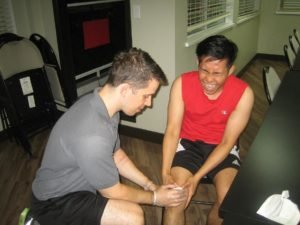Lateral meniscus tear involves damage to the semi-circular cartilage on the exterior of the knee joint. In every joint, there are 2 crescent-shaped cartilage menisci that works by cushioning and supporting the joint. They can be damaged by twisting movements or traumatic injury as well as deterioration due to the aging process.
What are the indications?
- Knee pain and tenderness around the exterior surface, particularly along the joint line
- Swelling arises within 24-48 hours after the injury
- Pain is produced when the knee is bent or when squatting
Management of lateral meniscus tear
The treatment for a lateral meniscus tear includes conservative measures which includes rest. In case these measures are not effective, a doctor might recommend surgery.

Initial care
The RICE method (rest, ice, compression, elevation) is used for swelling. Gentle exercises must be done to maintain the strength of the quadriceps muscle but be careful not to aggravate the symptoms.
A knee support can be used to provide protection to the joint as it heals. Additionally, a glucosamine supplement can help promote healing.
Medical care
The initial objective of a sports injury professional is to properly diagnose the injury. This is done using specific tests for meniscal tears such as the McMurray’s test. Depending on the findings, the doctor might proceed with conservative treatment or surgery.
Conservative treatment
For a small-sized tear or degenerative meniscus, conservative treatment includes the application of ice, compression and NSAIDs such as ibuprofen. A knee support or brace is used if the joint feels unstable.
Electrotherapy such as laser therapy, ultrasound and TENS can also be used as part of treatment. Once the pain has settled, exercises must be started to improve the range of movement, balance and maintain the strength of the quadriceps muscles.
Surgical intervention
If the lateral meniscus tear is severe, arthroscopic surgery is required to fix the lesion. The objective of surgery is to preserve as much of the cartilage as possible.
In most cases, the procedure involves stitching of the torn cartilage. Remember that the success of the surgery is based not only on the severity of the tear but also the age and physical condition of the individual. Individuals who are younger and fit usually have better outcomes.
After surgery, a rehabilitation program is started for the individual which includes balance training and strengthening routines.
Quick Note / Disclaimer
The material posted on this page on a lateral meniscus tear is for learning and educational purposes only. To learn to recognize and manage joint injuries including a meniscus tear, register for a first aid and CPR course with one of our training providers.
